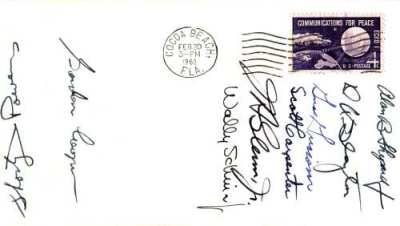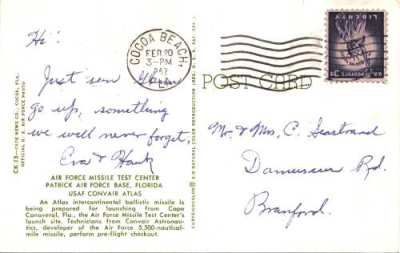A space cover for the launch and recovery date of astronaut John Glenn, Jr. is shown for the first orbital space flight of a NASA astronaut, February 20, 1962. This important cover is also signed by all seven Project Mercury astronauts and is also signed by their escort officer, Shorty Powers of the NASA Astronaut Office, Cape Canaveral, Florida.Space Cover #379 - All seven astronauts!
The orbital flight of Mercury Atlas-4 on Sept. 13, 1961 was originally intended to be a suborbital flight with a chimpanzee astronaut. This became the subject of some humor by veteran U. S. Air Force fighter pilot and test pilot Chuck Yeager, who chuckled and said to newsmen anticipating an upcoming obital space flight, "A monkey's gonna make the first flight!"
Yeager commented further that to be a Project Mercury astronaut, test pilot skill and pilot expertise were not required. This flight, though, did not have a monkey as its pilot, only a robot astronaut, but Yeager's comment did come true when Space Monkey Enos adroitly completed his orbital space flight, Nov. 29, 1961. Would an astronaut do as well?
Russian cosmonauts Yuri Gagarin and Gherman Titov had already beaten Project Mercury astronauts into orbital space flight and proving also that the Soviet Union was dramatically ahead of the United States' fledgling space program. Now it was NASA's turn to show that the U.S. also could catch up with the Russians.
Close behind Titov's orbital flight, it came down to the last Project Mercury candidate to be selected for the Mercury program, and it would be his orbital space flight mission to accomplish this. The pilot selected was a record setting USMC jet pilot by the name of John H. Glenn, Jr. Glenn would have to set this record for the United States by being the first NASA astronaut to achieve orbital space flight.
He would also have to survive a fiery return from space and Earth orbit and to make a perfect splashdown in the Atlantic Ocean with recovery by a U.S. Navy recovery team on station on USS Lake Champlain.
During Glenn's recovery, many things could have gone wrong including a possibly damaged parachute that was needed for reentry from space, possible overshooting of the primary recovery ships' footprint, and a possible repeat of the problem recovery of astronaut Gus Grissom in which the astronaut almost drowned when his space capsule sank after splashdown. But for Glenn's mission, all these problematic issues worked out right.
John Glenn indeed earned the honor of becoming America's first astronaut to orbit Earth and to successfully complete this historic space flight. It was a red letter day for NASA and for America!
The successful launch and orbital spaceflight of astronaut John Glenn was a tremendous success for NASA and for the U.S. space program. The postcard above shares this excitement in the couple Eva and Hank writing to their family in Branford, Florida, from Cocoa Beach, Florida, after seeing Glenn's launch, "Just saw Glenn go up, something we will never forget."













